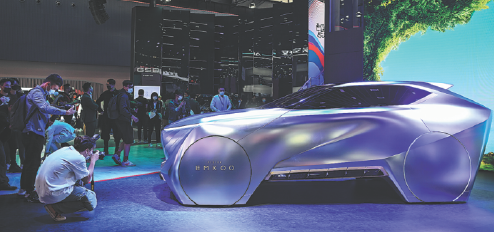Concepts and premieres offer vision of future in Guangdong

A concept car of GAC Group attracts visitors' attention at the 19th Guangzhou auto show, which is running from Nov 19-28 in the capital of South China's Guangdong province. CHEN JIMIN/CHINA NEWS SERVICE
International and Chinese companies delight motor fans at car exhibition
Chinese and international carmakers are showcasing 1,020 models at the ongoing Guangzhou auto show, the last of the annual major events for car aficionados in the country this year.
Gasoline vehicles outnumber electrified models three to one, but the latter are commanding more attention as the industry is fast shifting toward electrification.
Despite the absence of Tesla and Wuling, two of the bestselling electric carmakers in the country, eye-catching and mind-blowing products are in plentiful supply.
Aion, the electric arm of Guangzhou-headquartered GAC Group, made the global debut of its LX Plus SUV, which among other things has a range of more than 1,000 kilometers on one charge.
Its dual electric motors enable the 4,835-millimeter long vehicle to accelerate from 0-100 km/h in less than three seconds.
Xpeng, the New York-listed Chinese startup, unveiled its flagship SUV G9. The model is based on the startup's third-generation electrical architecture, said the company.
It is also the first in China to feature gigabit Ethernet, whose faster data transmission enables high-level automated driving, smart onboard functions and vehicle updates over the air.
The G9 is also the first 800-volt production model in the country. The company said the model can extend its range by 200 km by charging for just five minutes.
Great Wall Motors' electric Shalong marque started presales of its first model, a four-door coupe called the Jijialong.
It is the first model globally to sport four lidar sensors, a remote sensing system of light detection and ranging, which are provided by Chinese technology giant Huawei. The coupe also uses Huawei's smart chips for autonomous driving functions.
The Jijialong has a maximum output of 400 kilowatts and a top torque of 750 Newton meters, accelerating from 0-100 km/h in 3.7 seconds.
It has a range of over 800 km and is compatible with 800V charging facilities, which can extend its range by up to 400 km in 10 minutes.
International carmakers are coming up with their top models in an effort to consolidate their leading position in the age of gasoline vehicles.
Mercedes-Benz launched two electric models at the event, the EQA and the EQB, both of which have a range of more than 500 km on one charge.
The carmaker said another electric vehicle, the EQE, will follow later this year, which will bring the German carmaker's electric models in China to four. Its first electric model, the EQC, hit the market in late 2020.
The carmaker said it would get ready to go all-electric by 2030 where market conditions allow, aiming to lead in sustainable luxury mobility.
BMW launched its electric iX SUV, which made its debut at the Shanghai auto show in April.
The xDrive50 version has a maximum output of more than 370 kW, enabling acceleration from 0-100 km/h in under five seconds. It has a range of more than 600 km.
GM's Cadillac is showcasing its Lyriq SUV at the auto show, which began presales a day ahead of the event.
The mid-size SUV is the first SAIC-GM model built on GM's Ultium platform, representing the start of Cadillac's transition toward intelligent battery-electric vehicles.
It has a range of more than 650 km and supports fast charging-a 10-minute charge can increase its range by 96 km.
The Lyriq is equipped with GM's Super Cruise autonomous driving technology, which integrates automatic and command-based lane changing.
China is the world's largest market for electric cars and plug-in hybrids. Their sales soared 141.1 percent year-on-year to 321,000 units in October. It amounted to around 20 percent of total vehicle sales in that month, according to the China Passenger Car Association.
During the first 10 months, the sales of new energy vehicles totaled 2.14 million units, a 191.9 percent surge from the same period of 2020.



 Print
Print Mail
Mail

